Cooking classes have been taking off recently as a must-do while traveling. It makes sense. You go to a foreign country, love the food, and want to take it home with you. However, let’s be honest. Our foreign food back home is completely adopted by our pallets! What better way to get the real deal than to learn it in-country and recreate it yourself!?
- Sumiya Bunjiro Brewery Presentation
- What is Mirin?
- The real deal: Mikawa Mirin (三河みりん)
- The impostors: Mirin and Mirin-like seasonings
- How to use Mirin
- BentoYa Online Japanese Cooking Classes
- BentoYa Japanese Cooking Class in Tokyo: Vegan Sweets made with Mirin
- Making Mirin Pudding
- A quick and easy Japanese lunch
- Like this post? Share it on social media for later!
[Editor’s Note: This post was originally published in December of 2018 and has been updated for freshness, accuracy, and comprehensiveness.]
Disclosure: Kristenabroad.com is a participant in the Amazon Services LLC Associates Program and other affiliate programs. For some links to products or services in this article, I may earn a small commission from you using my link. The price for you is not affected.
Sumiya Bunjiro Brewery Presentation
The future owner of the Sumiya Bunjiro Brewery Co., Ltd. was present to give us the history and process of making their Sanshu Mikawa Mirin (三州三河みりん). She also gave us background on the many various uses.
While the company was started in 1910, according to ancient Japanese text, mirin has been around for five hundred years. During the Edo period (same time as all of the castles), it was an expensive beverage.
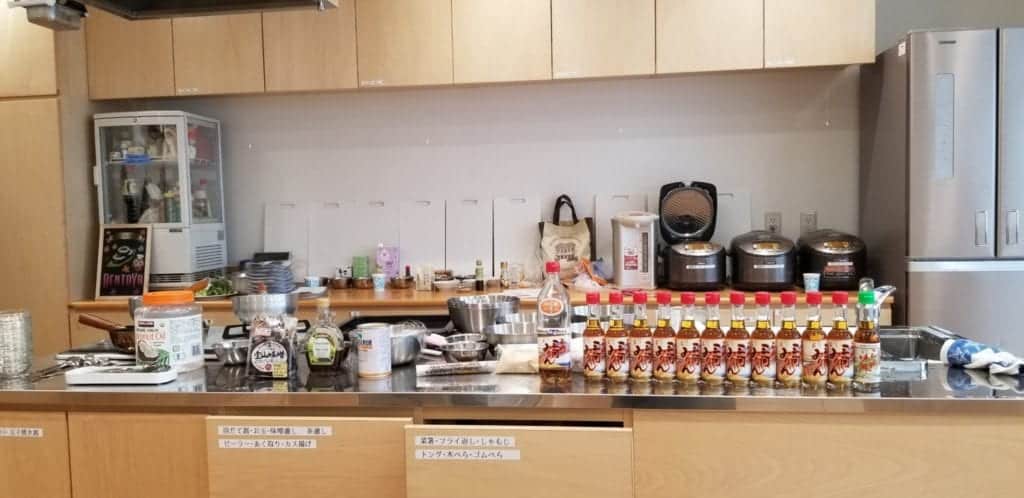
What is Mirin?
Mirin, a sweet rice wine, is a versatile seasoning that can add sweetness and texture to Japanese dishes. Similar to sake but with slightly lower alcohol content and higher sweetness. That sweet flavor comes from how it’s made, not because there is sugar added to it.
Though originally it was used as a beverage, eventually it began being used as a seasoning in Japanese cooking. It can be cooked down to make a lovely sweetener (think honey but not as thick). We sampled two types of mirin that the company produces and I must say, I’d drink them!
The real deal: Mikawa Mirin (三河みりん)
Mikawa is located in the eastern part of Aichi Prefecture. It has suitable conditions for brewing Mirin and has the largest number of brewers in Japan. Mikawa Mirin (三河みりん) is made from glutinous rice, rice malt, shochu and goes through a single distillation process. The Sumiya Bunjiro Brewery Co., Ltd. makes it with the traditional manufacturing method. This takes nearly two years to complete for the high-quality glutinous rice to be brewed and matured.
Sanshu Mikawa Mirin (三州三河みりん) has about 14% alcohol and is a deep amber color. The generic name for this “top-level” product is Hon-Mirin (本みりん). Hon means “true” or “origin”.
The impostors: Mirin and Mirin-like seasonings
The main difference between hon-mirin (which is what we used for this Japanese cooking class with the Sanshu Mikawa Mirin 三州三河みりん) and mirin, is that straight mirin uses sake instead of shochu in their ingredients. Because of this and other process differences (only a few months of processing), they tend to have a lighter coloring.
There are industrially made mirin on the market that has more additives and is not as “pure” as traditional methods. Industrial made is not as painstakingly made and is quickly brewed in a few months’ time. They still have similar alcohol levels but aren’t as high quality.
To make it even more complicated, during and after the war, liquor laws made it difficult for grocery stores to sell true mirin. Additionally, due to the high cost since rice was scarce. As such, “煮切り” (nikiri) came into existence, which is boiled down to reduce the alcohol content. There is also “塩みりん” or “salt mirin” that adds salt to bring down the alcohol content. These are referred to as “mirin like” products or みりん風調味料 (mirin fuchoumiryou) and are highly chemical seasonings with little (1%) or no alcohol.
If you are in the market for mirin, watch out to get the real deal! Check your ingredients -if there is added sugar, it’s not real mirin. If there isn’t alcohol, it isn’t real mirin.
How to use Mirin
There are many uses for mirin and it is a great condiment to have in any kitchen. Especially if you like to make japanese food.
- Gives a gloss and luster to coatings better than that of sugar — think teriyaki sauces!
- Draws out flavors of a dish
- Can be used to tenderize meats (again, with your teriyaki)
- Eliminates odors on smeller food items
- Adds a mild sweetness
- Is another way to add umami (miso can be used as a “secret” ingredient for that too.)
The company has a few different authentic mirin and the class used Sanshu Mikawa Mirin (三河みりん) as the sweetener in a few dessert items.
In dishes that call for honey, you can use mirin as sweetener instead, the class suggested.
BentoYa Online Japanese Cooking Classes
Since attending this Japanese cooking class, a lot has happened in the world. Including the COVID-19 pandemic. As such, like many others, BentoYa had to reevaluate its business model. Which included moving to online courses. And while it’s more fun to have the hands-on experience, now more people (i.e. those of you not in Tokyo!) can enjoy these vegan sweets (and their other vegan recipes) from the comfort of your home.
Their Japanese cooking class cost about 3300 yen. If you are looking for some quick and simple recipes, they also have a YouTube channel to check out.
BentoYa Japanese Cooking Class in Tokyo: Vegan Sweets made with Mirin
One nice thing about this Japanese cooking class in Tokyo? No prep work! I really love how there are community kitchens to use. There are three cooking stations in this room similar to this one as well as the front display where the instructor normally is.

Making Mirin Pudding
This is a vegan class so we didn’t use any animal products. It was interesting to learn about the different things you can use instead. And the end product is so tasty. This style of pudding is quite common as a dessert in Japan. Simple and not too sweet.

Kanten (寒天) is a natural gelatinous product that comes from algae. It is a great substitute for gelatin in the pudding.
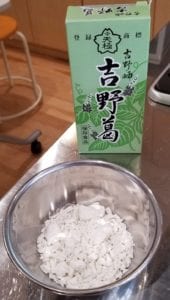
Kudzuko (葛粉, sometimes Kuzu in English) starch comes from a root plant called Kuzu. It’s an exceptional thickener. I was surprised how fast it could take effect! Sometimes brewed as a tea as it is actually very good for upset stomachs!
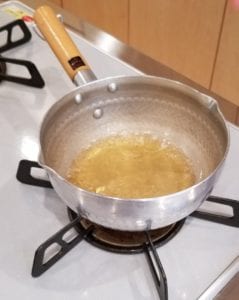
The sweetness comes from boiling down the Mirin. You cook for a few minutes to evaporate the alcohol and turn it into more of a syrup consistency. We also add it to the top to give it that sheen. Presentation taught so much!
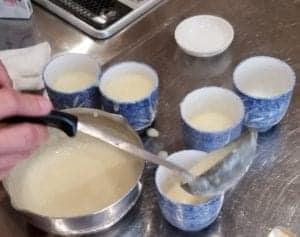
You cook the ingredients all together for a few minutes to thicken it up and you’re done! Chill it for a bit in the freezer if you want it right away, else in the fridge works too.
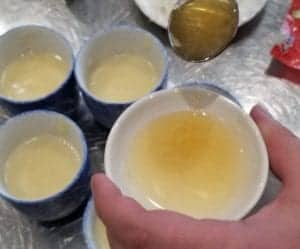
Don’t forget to add the bit of sweetness on top!
A quick and easy Japanese lunch

As every class with Bentoya Cooking ends with trying out your creations, we also made some onigiri with soy meat. Can’t just eat sweets for lunch! Well, you could, but your waistline might not like it. However, cooking with mirin, there is no added sugar for all the sweetness so it’s actually healthier!
This soy product starts out dried, you cook it in water to reconstitute it and then ring out the excess water before cooking up and adding flavoring.

Hint for making onigiri. Use saran wrap. Keeps your hands less sticky with the rice. I’m starting to get better at them if I do say so myself! Another pro tip: don’t put too much filling or rice, a smaller portion is much easier to deal with!


I love how easy a good miso soup is. Some homemade dashi made with seaweed for umami instead of fish flakes, add some leak and onion to it, drop in some miso and you are good to go!
The finished product! いただきます! Itadakimasu! Thank you for the food, let’s eat!
Looking for another Japanese cooking class in Tokyo? Check out my other experience with BentoYa Cooking.
Like this post? Share it on social media for later!

